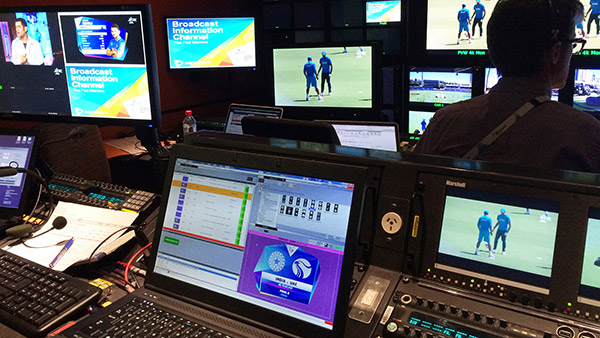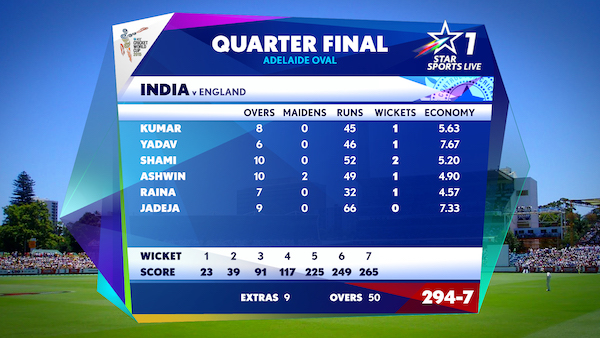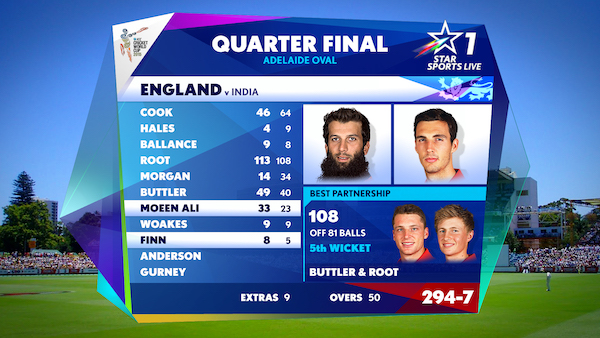Customer Stories
AEGraphics Bowled Over by Vizrt and Matrox Video 4K Solutions
Cricket is not just a game, it is considered more sacred than religion in many parts of the world! Passionate fans all around the globe—the young and the old, the rich and the poor, the illiterate to prestigious school educated—follow the game and their favorite players faithfully by watching all the matches, live on the cricket grounds, or on television.
The Cricket World Cup (CWC), held every four years with the top 14 teams in the world competing, is a much anticipated event with a large viewership, typically in hundreds of millions.
The 2015 Cricket World Cup was held in Australia and New Zealand. Star Sports, the host broadcaster for the 2015 Cricket World Cup, covered every match live. All the matches played by India, plus the semi-finals and final, were broadcast live in 4K to local cinemas in India. Alston Elliot (AEGraphics), one of the world’s leading providers of television graphics and data solutions, was asked to deliver 4K graphics on Star Sports’ live 4K coverage of the CWC games.

From their head office in the UK and subsidiary companies in South Africa, India, and Australia, AEGraphics delivers graphics on many of the most prestigious sporting events across the globe. What sets them apart is their ability to offer clients a complete turnkey solution—from the original concept and design of a graphics look, to a bespoke range of software solutions, to the final onsite delivery at live studio and outside broadcast shows. Their philosophy for success is underpinned by their ability to choose the best tools for each individual job. AEGraphics wanted to ensure successful implementation of this project as well, so they approached Vizrt, their primary graphics platform provider, for a specialised solution. Vizrt, in turn approached Matrox for the necessary video cards for the project.

The Challenge
The process of delivering 4K graphics was hitherto uncharted territory for AEGraphics. Other suppliers had encountered difficulties and performance issues in using 4K graphics and AEGraphics was essentially testing the waters with this project. They had to make sure that the core elements were suitable for the 4K solution.
Generating graphics content in 4K, which is four times the normal HD resolution and double the frame rate, meant extra processing&eight times the processing power needed for normal HD resolution. This necessitated a technically innovative, powerful, glitch-free and robust solution, with a proven capability to handle 4K workflows.
Testing and Deploying the Solution
For testing purposes, AEGraphics was supplied with two Matrox DSX LE3/4KO/550 SDI video cards, which were installed in an HPZ820 chassis supplied by Vizrt.
On receipt of the equipment from Vizrt and Matrox, AEGraphics began a stringent testing and development phase in their UK head office. They found that the workflow for 4K did not differ significantly from their previous workflow. In fact, AEGraphics was happy with the way that the 4K process fitted into their standard graphics workflow—providing fill and key signals to a switcher that overlaid the graphics onto live video content. Each Matrox DSX LE3/4KO/550 card fed four 3G SDI signals to carry one 4K feed. One card provided the fill signal and the second card provided the key signal to the switcher. The system performed well for 4K in testing and was shipped to various outside broadcast sites at the Cricket World Cup in Australia and New Zealand.
AEGraphics provided the output of its UHD Vizrt machine direct to NEP Australia (the facilities provider), who provided both the 4K production and broadcast facilities. There was some concern about the synchronization of the eight SDI channels that the fill and key signals consisted of and both AEGraphics and NEP were impressed to find that the signals were delivered in sync by the Matrox cards at all times.
Eight flypacks that included four Viz Engines driven by AEGraphics software were supplied for the host broadcast main graphics feed. An unbranded slave feed was also provided for Doordarshan, the Indian terrestrial state broadcaster. In addition, the ICC (International Cricket Council) needed an independent feed for the large arena screens, which required bigger fonts for better legibility. The graphics were driven by in-house software applications. This allowed for quick population of graphics with data and also removed the chances of errors.
For their regular HD graphics delivery on Cricket World Cup coverage, AEGraphics used 24 HP Vizrt machines with Matrox X.mio2 Plus SDI video cards. AEGraphics uses Matrox cards extensively. Three Matrox X.mio2 Plus cards are used in every one of their eight OB (outside broadcasting) vans in the UK for regular HD workflows.
Star Sports broadcast live all the matches in the 2015 Cricket World Cup held in Australia and New Zealand. All the matches played by India as well as the semi-finals and final matches were broadcast in 4K to external set top boxes, to cinema locations in India. These were the world’s first true 4K broadcasts, and the stunning picture quality was enriched further with 4K graphics, provided by AEGraphics in collaboration with Vizrt and Matrox. Graphics for the regular HD coverage by Star Sports, screened throughout the world, were also supplied by AEGraphics. Eye-catching 4K graphics were used to display current scoreboards as well as player walk throughs (wicket partnerships, pictures of players with corresponding information on the total number of matches played, their average runs per match, number of centuries and half centuries scored, average runs per over, average wickets taken per match, total wickets and so on).

The graphics displayed kept the millions of viewers (peaking at a billion for the match between India and Pakistan) well informed and engaged in the game. The 4K pictures, with four times the quality of HD, enabled AEGraphics to generate smaller graphics without losing the important details they contained. “UHD brought extraordinary clarity to the pictures, particularly for crowd shots, and full-frame graphics could be displayed without any artefacts,” said Nick Baily, CEO, Alston Elliot.
“Without assistance from Matrox we would have been unable to deliver 4K graphics for this event,” stated Stuart Coles, Sales Director, AEGraphics. “We are pleased to be one of the first graphics companies to deliver 4K graphics and Matrox enabled us to achieve this. The client was extremely happy with the results produced and a proven ability to deliver 4K graphics is another tick in the box for our company.”
Future Plans
A newer generation Matrox X.mio3 SDI video card, supported by Vizrt, was demonstrated at the 2015 NAB show. A single Matrox X.mio3 card is capable of handling fill input plus fill and key output signals for 4K. AEGraphics plans to invest in at least two of these Matrox X.mio3 cards to assist with some further 4K testing with their clients in India.
Whether moving to Matrox X.mio3 from X.mio2 or DSX LE3, the continuity of workflow is a big advantage that is assured to AEGraphics. Matrox allows Vizrt to reuse the same workflow for 4K as they were using for HD, so even with an upgrade in the technology, the actual workflow remains the same.
AEGraphics is also considering the purchase of a Matrox Mojito 4K card to assist their designers working with 4K content, using Adobe software.
